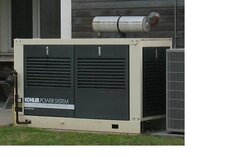Well the power is out due to the big ice storm, so now we're wihtout some of the basic services we're so used to. heat is fine since its relatively mild out and the woodstove is cranking away...along with that we've got the top to cook on and the gas grill is there as well. Problem is we've got no water since its an electric pump, so we can't flush the toilet, can't make hot water for a shower (whihc we can't take wihtout pressure anyways) and no fridge either. I can always put the food in a cooler outside if I have to but what about water? Guess I could always put a huge bucket outside and let it collect whatever water it can from the rain and snow and use that to dump water into the toilet. Showers will have to wait.
I don't have a generator...frankly while I've thought about buying one before we've never lost power for more than an hour or so over the last few years. If I were to purchase one I know I can plug things into the 100 outlets and run them, so the fridge can get taken care of, but is there any way to work with the water pump since its tied into the breaker panel? I beleive its a 20 amp breaker (though I'm not sure what it actually draws). It doesn't amke sense that I could use a male to male extension cord and just plug into the house and backfeed through the breaker panel...in fact that seems like it might be dangerous to some extent...but I really don't know.
My well is 440 feet deep so some kind of hand pump is probably out of the question.
Any thoughts? I think I'm just SOL and the time to think about this is when the sun is shining and the power is on and not when the outage actually happens...but thats just the way it is. My chief concern is that we may be looking at an extended outage.
I don't have a generator...frankly while I've thought about buying one before we've never lost power for more than an hour or so over the last few years. If I were to purchase one I know I can plug things into the 100 outlets and run them, so the fridge can get taken care of, but is there any way to work with the water pump since its tied into the breaker panel? I beleive its a 20 amp breaker (though I'm not sure what it actually draws). It doesn't amke sense that I could use a male to male extension cord and just plug into the house and backfeed through the breaker panel...in fact that seems like it might be dangerous to some extent...but I really don't know.
My well is 440 feet deep so some kind of hand pump is probably out of the question.
Any thoughts? I think I'm just SOL and the time to think about this is when the sun is shining and the power is on and not when the outage actually happens...but thats just the way it is. My chief concern is that we may be looking at an extended outage.



 ! You could damage your generator.
! You could damage your generator.